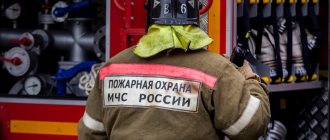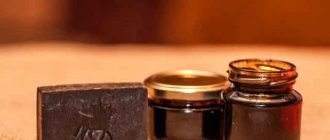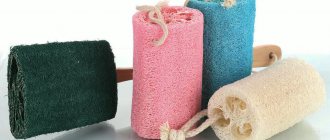I use asbestos in the bathhouse and don’t listen to anyone, because I know how to use it correctly
My decision to put a layer of asbestos under the stove caused heated discussions among friends. Even Nina looked at me incredulously at first and fought the desire to give a lecture about the dangers of this terrible mineral. I compare horror stories about asbestos to horror stories about GMOs.
They are on everyone's mind, but no one knows anything about it. Well, I will dedicate this post to debunking one of the myths that plague humanity.
It so happened that I crossed paths with asbestos from birth. It's simple - I was born in the Ural city of the same name Asbest
. It was from this city that the extraction of the material that causes so much controversy today began in Russia. Rumors about how dangerous asbestos is only fueled the curiosity of the boys in our city. Forays for the treasured pieces of the mineral were made regularly - without dire consequences.
Fate turned out to be such that in medical school I again encountered asbestos. This time in the context of studying asbestosis, a disease caused by inhalation of asbestos dust.
During practice, our course repeatedly looked inside people. As luck would have it, not a single case of asbestosis presented itself. I went to a pathologist with this question, and he confirmed my guesses. In all the years of practice, no bodies with such a disappointing diagnosis have been reported.
I have heard a lot about the hysteria surrounding asbestos.
Every “green” strives to give a lecture about how this material is poisonous. It poses a threat not only to individuals, but to all humanity. I can answer the presented theory only with practice and indisputable facts. Over the years of living in my native Asbest, I have not noticed a high mortality rate due to this ill-fated building material.
I'll make a retreat. There are two types of asbestos: amphibole and chrysotile.
The first is mined in Canada and poses a real health hazard. The risks that people are exposed to during “contact” with chrysotile asbestos have not been scientifically proven to this day. But due to its relationship with its dangerous “dangerous” amphibole brother, our asbestos suffers from persecution on a global scale.
Amphibole asbestos fibers enter the lungs and are not excreted for a year or more. Because of this, pathological changes begin in the organs, which can become irreversible. The consequences of inhaling amphibole include lung cancer, stomach cancer and mesothelioma.
Chrysotile asbestos does not have similar properties - it leaves the respiratory system after 2-3 weeks without harm to human health.
Harm from inhaling peridot is observed, but for symptoms to appear, you need to constantly breathe over asbestos dust.
To minimize the impact of asbestos, it needs to be securely hidden under the stove, which is what I did. I laid carbon sheets inside the walls, covered them with foil and stainless steel sheets. Of course, some percentage of peridot will end up in the air. But the body can cope with such an amount of substance without difficulty. Even if the particles get into the lungs, they will leave them after a couple of days.
Source
The harm of asbestos to human health - two opposing versions
Question: Are asbestos and asbestos-containing materials harmful to human health?
Is there a negative impact? Asbestos is a natural fine-fiber material of the silicate group. There is white chrysotile and amphibole asbestos, photo 1. Asbestos fibers are thin and flexible and have sufficient tensile strength. Asbestos is added to cement and other mixtures in the production of building materials and products.
Photo 1. White asbestos (chrysotile)
Asbestos is used in various industries:
- construction;
- automotive industry;
- cosmic.
In the construction industry, asbestos is produced, photo 2:
- asbestos-cement pipes with a diameter of 0.1 to 1 m;
- flat sheet slate (GOST 18124-95 Flat asbestos-cement sheets. Technical conditions);
- corrugated sheet slate (GOST 30340-95 Corrugated asbestos-cement sheets. Technical specifications).
Photo 2. Asbestos-cement products
There are two opposing versions about the harm of asbestos:
- asbestos is not a harmful material;
- asbestos is a harmful, carcinogenic material.
Let's briefly look at these two versions.
Version No. 1. Asbestos is not a harmful material
It has been established that white (chrysotile) asbestos is an absolutely harmless material to human health, but amphibole asbestos is a carcinogenic material. Amphibole asbestos is prohibited for use in the production of building materials.
Asbestos associated with cement is not dangerous and does not emit harmful particles to human health. Asbestos dust can cause harm with prolonged contact. Such dust in the form of small fibers settles in the human lungs and, with sufficient accumulation, leads to the occurrence of the following diseases:
- asbestosis;
- fibrosis;
- cancer;
- emphysema;
- bronchitis.
I would like to note that the above diseases do not arise due to a few breaths of air containing asbestos dust, but through long-term exposure to such dust for several months or even years. Such an environment is the premises for the production of asbestos products. Once asbestos fibers enter the lungs, they are not removed from there, but remain for life.
In accordance with regulatory documents (GOST 539-80, GOST 1839-80), free-flow and pressure high-density asbestos-cement pipes can be used for water supply systems. Ordinary asphalt emits several tens of times more harmful carcinogens than amphibole asbestos. For example, in Russia, the use of asbestos-cement building products is permitted by the “Hygienic Standards (GN 2.1.2/2.2.1.1009-002)” and must have a sanitary and epidemiological permit.
The ban on asbestos products in the form of slate and asbestos-cement pipes in Europe is associated with commercial competition, since this material is superior in its properties to many other products. And due to the fact that there are practically no asbestos deposits in Western Europe, asbestos materials simply began to be banned. Asbestos ranks 119th out of 260 possible carcinogens. For reference, nicotine ranks first in carcinogenicity, followed by benzopyrene.
When operating asbestos-containing structures and products, asbestos fibers are not released.
Version No. 2. Asbestos is a harmful carcinogenic material
- Western countries in the 90s of the 20th century banned the use of asbestos slate in residential premises and limited its use in industry due to its negative impact on human health, and since 2005 they have completely banned it.
- The World Health Organization (WHO) has concluded that white asbestos is also a dangerous carcinogen and belongs to group 1 carcinogens.
- Occupational disease from exposure to asbestos in the United States over the past 50 years has amounted to about 8 million people.
- Approximately 60 countries around the world have partially or completely banned the use of asbestos.
- Canada produces about 10% of the world market for asbestos materials and products. Of the total volume produced, over 95% of asbestos is exported to third world countries.
Below we present from the Encyclopedia of Occupational Health and Safety a table of occupational diseases that are associated with exposure to asbestos (Table 1).
Table 1. Occupational diseases associated with amphibole asbestos
| Pathology | Affected organs | Disease (condition) |
| Benign | Lungs | Asbestosis (diffuse interstitial fibrosis) |
| Pleura | Diseases of the lower respiratory tract (pneumosclerosis limited to the peribronchial region). Chronic respiratory diseases | |
| Leather | Pleural plaques, visceroparietal reactions including mild pleural effusion, diffuse pleural sclerosis and atelectasis. Asbestos grains. | |
| Malignant | Lungs | Lung cancer (all cell types), laryngeal cancer. |
| Pleura | Pleural mesothelioma. | |
| Other mesothelium-lined cavities | Mesothelioma of the peritoneum, pericardium and scrotum. | |
| Gastrointestinal tract | Gastric cancer (esophagus, colon, rectum) | |
| Other pathologies | Diseases of the ovary, gall bladder, pancreas, kidneys |
After reading this, I will leave it up to you to choose whether to consider asbestos-containing products hazardous to health or not.
Asbestos in the construction of baths.
I thought that many people had forgotten about it, but those who remember and ask about it, we talk about it, and they buy alternatives. BUT! An interesting thing happened. A builder and a customer came to the store and started asking for asbestos boards. In response to our monologue that it was harmful, the builder waved it off and began to tell the client that it was simply not profitable for us to sell it, since it was cheap. Ladies and Gentlemen. In large stores, where decent people work, there are many product alternatives at different prices. And yes, having worked as a salesman, I can agree that an expensive product is better than a cheap one by 70 percent. As a result, the builder began to prove to me that we, the whole world and other builders, are mistaken, and he is the only one right. I began to name the names of his clients, for whom he built baths, among whom were quite influential people in our city, to which I had to unprofessionally (rather rudely) put the person in his place. So let's figure out what asbestos is. Wikipedia tells us: Asbestos
(Greek ἄσβεστος, - indestructible) or mountain flax
- a collective name for a number of fine-fiber minerals from the class of silicates, which in nature form aggregates consisting of the finest flexible fibers. It is used in a wide variety of fields, such as construction, the automotive industry and rocket science.
It seems that everything is not bad. Read on:
It is a category 1 carcinogen according to the IARC classification.
Where is it used
If you study the question of what asbestos is needed for, you will notice that it is used in various fields, including industrial production and construction.
Construction
In installation work, its fire resistance and thermal insulation are especially valued. Therefore, very often when installing wall panels or laying floors, asbestos boards or wool made from the same substance are used.
Cables and various metal and concrete structures are usually treated with this mineral in the form of spraying. This is how they acquire fire-resistant properties.
In addition, in some houses, cement pipes with the addition of this substance are installed. It is thanks to him that they become stronger and more durable.
Asbestos has also found application in the chemical field, where it is used to make various plastics, paper and paint and varnish products.
Here this mineral is used in the manufacture of fabrics for workwear. It is used to make protective gloves, helmets and suits. In addition, brake flanges and pipe seals are also made with its addition.
Design, types and rules for creating a chimney for a bath
An important element of any bathhouse is the chimney, which ensures optimal removal of combustion products from the premises from the use of the sauna stove. Any structure requires its installation, and at the same time it must be reliable, safe and inexpensive. Often, many bathhouse owners even think about creating it themselves, and this can be done quite easily and without complications if you have a good understanding of the current operating technology. It should be noted that the temperature at the outlet of the sauna stove exceeds 600°C, and for fire safety purposes it is necessary to carefully consider the choice of materials and the quality of the chimney elements.
Chimney device
This design comes in different forms, all of which are made from a variety of materials and have different designs. They can have one or two contours, and brick or steel, ceramics or other suitable materials can be used for their production.
Is asbestos harmful?
Asbestos dust is a carcinogen
upon contact with the respiratory tract. You can verify SanPiN 1.2.2353-08 “Carcinogenic factors and basic requirements for the prevention of carcinogenic hazards”
Asbestos dust causes great harm. During work, namely drilling, cutting and other activities, it releases a lot of dust, which, when it enters the respiratory tract, settles in them and is not removed by anything. This dust causes lung cancer and there is also a disease called Asbestosis.
Author: Nephron - Own work, CC BY-SA 3.0, https://commons.wikimedia.org/w/index.php?curid=7597853
Where else is asbestos found?
This mineral is still present in outdated car models, some residential buildings, and old country houses. For many summer residents, asbestos in the bathhouse is a source of particular harm to health. After all, back in Soviet times it was used as a fire-resistant material for various coatings.
Asbestos does not burn, but when exposed to high temperatures it begins to break down, releasing harmful amphibole. Not all owners of country cottages are aware that they are exposing themselves and their household members to mortal danger.
Asbestos sheet for bath
You are using an outdated browser. This and other sites may not display correctly. You need to update your browser or try using a different one.
Impregnations, paints, oils, waterproofing from FORUMHOUSE
FORUMHOUSE turns 15 this year! During this time, millions of people have built their own homes thanks to the knowledge gained from our website. We want only high-quality and safe materials to be used during construction, which will help preserve houses for many decades. Therefore, we have launched a project of our own FORUMHOUSE brand, under which we will produce building materials and equipment that will serve you for many years and make your life in your own home more comfortable and safer.
To the rescue - sandwich pipes
For those who want to install a safe chimney in their bathhouse, we suggest using a sandwich pipe. This design includes several sections that can easily be placed inside each other, i.e. looks like a multi-layer cake.
Here are the main components of a sandwich pipe:
This creative design represents the insulation of a chimney built into the overall system and is designed to solve two problems simultaneously:
The sandwich pipe is easy to assemble yourself and can be used for a sauna with an iron stove or bathhouse. What to do if you built a Russian steam room with a brick stove? Below we will consider how to line the pipe in this situation in order to protect it from ignition.
What is made from asbestos: list
The list of products that may contain asbestos is quite large:
- Roofing and wall products. For example, asbestos is used to create sheets of slate and foam concrete;
- Plates for facades;
- Water pipes;
- Fireproof fabrics;
- Non-flammable asbestos cardboard (asbestos cardboard);
- Bricks;
- Fire curtains and doors;
- Thermal insulation (asbestos wool, foam asbestos);
- Brake bands;
- Rubber products;
- Silicate coatings;
- Vinyl Floor Tiles;
- It is used in the automotive industry, for example, it is part of the materials from which brake pads are made.
- Mastics, sealants, construction drilling fluids, putties and mixtures;
- Many other products where thermal insulation, fire resistance and flexibility are required.
Russia is one of the leaders in asbestos mining. Next comes China. Brazil and Kazakhstan are a little behind the Celestial Empire in this regard.
Metal protective screens
On the construction market, the most common metal protective screens are made of steel or cast iron. Many manufacturers of iron furnaces provide thermal insulation for their products, providing them with special casings.
Choosing protective screens is quite simple, because depending on the side of the furnace to be insulated, you can purchase a front or side panel. Installing such screens will also not cause difficulties, because the manufacturer provides special legs that can be easily attached to the floor.
Next we should talk about the installation rules. The panels themselves are installed at a distance of 1-5 cm from the stove, but a distance to the adjacent wall is also required. Protective screens reduce the radiated temperature to 80-100°C, which allows them to be installed 50 cm from a parallel wall.
How to replace asbestos in a sauna stove?
What material has such inflammability?
Asbestos is considered not a very environmentally friendly material, so it is better to refrain from using it in a bathhouse. Instead, you can use foiled basalt wool, for example, Rockwool Brandbatts.
You can also use vermiculite or magnesite boards. The former can withstand temperatures up to +1100 degrees, the latter 800-1000 degrees. The choice of materials in a bathhouse must be approached with special care, because some materials emit toxic substances when heated, and in a confined space this can be hazardous to health.
It depends on which unit (where) the asbestos needs to be replaced.
For example, instead of asbestos cord, which is used in chimneys (sealing pipes), you can use this heat-resistant sealant:
The same sealant can be used for repair work in the furnace, sealing cracks, crevices, and so on.
If you need a material that will protect the wall near the stove from fire (for example, now you have sheet asbestos there), then you can use this material GKLO,
Also, instead of asbestos, you can use protective screens, for example, made of stainless steel (sold as a finished product).
Superizol (calcium silicate, sheet material) is also a worthy substitute for asbestos. Minerit-Sauna (leaf),
Cracks due to temperature changes and can even explode
Asbestos pipes began to be produced back in the USSR. And although they can now be found on many houses as a chimney, they were originally produced for the reclamation of agricultural land. Previously, they were successfully used to arrange the upper part of the chimney. The main disadvantage of the material is that it easily cracks due to temperature changes. This can happen when a boiler or furnace heats up quickly. The presence of cracks in the chimney is a risk of fire.
In addition, there are many stories about asbestos pipes exploding. You will say how this can happen if the material can withstand up to 300 degrees. An asbestos chimney pipe is never installed immediately next to a stove or boiler, since the combustion products cool down when rising. But the walls of the asbestos pipe are not smooth enough, so soot easily settles on them. If cleaning is not carried out in time, the soot may ignite. If it burns, the pipe may break into pieces.
Is it possible to use an asbestos pipe and under what conditions?
You can use an asbestos-cement pipe for chimneys if several conditions are met.
- The main condition for using an asbestos product as a bathhouse chimney is to install it only in areas that are located at a considerable distance from the stove. You can install it as the final section of the chimney.
- The second condition is insulation and insulation. The pipe can be installed in a brick chimney or made into a sandwich using an external casing. This will significantly reduce the formation of condensation and increase fire safety.
Maintenance difficulties
The only way out is to constantly clean the chimney (see How to clean a chimney). But unlike brick and metal pipes, chimneys made from asbestos-cement pipes are difficult to clean due to the difficulty of installing inspection windows.
The main problem is condensation
Skeptics may argue that this explosion condition only applies to older furnaces and boilers. Modern boilers have increased efficiency, as a result of which their outlet temperature is much lower, 100 degrees, and an asbestos pipe for the chimney is quite suitable. There is a reason for this statement. But let’s repeat, let’s not look at the issue superficially.
Indeed, all modern boilers have good efficiency, and this is wonderful. This means that this necessary heat does not go down the chimney, but is mostly used to heat your home.
As you know, for normal combustion of fuel a supply of oxygen is necessary. Oxygen is supplied along with outside air. Oxygen is supplied along with outside air. Air is supplied by draft. But what affects the quality of traction?
Of course, the quality of the chimney. Many people believe that the chimney is designed to remove combustion products. But it is important to know that, by removing combustion products, the chimney provides a flow of fresh air into the firebox, which ensures normal combustion inside the stove, boiler, or fireplace. This is how traction is formed. The greater the temperature difference in the pipe with the outside air temperature, the better the draft.
The greater the temperature difference in the pipe with the outside air temperature, the better the draft.
Many people have encountered this problem. The old boiler worked fine with a regular brick chimney. It's time to change the boiler. They installed an ultra-modern, economical, high-efficiency unit - and the problems began.
Not only does the boiler not work as stated in the documentation, but on top of everything else, unpleasant-looking stains began to appear on the walls where the chimney pipe runs, and the beautiful brick pipe installed on the roof began to crumble.
Condensation stains
What is the reason? There is only one answer - condensation. Anyone who thinks that an asbestos chimney pipe in this case would be at its best is deeply mistaken. How can this be, because asbestos-cement pipes are not afraid of water, they are designed for this. Everything is correct for water. But the condensate in the pipe is not exactly water. Or rather, not water at all. Condensation in a chimney is a very aggressive solution of a mixture of combustion oxides and moisture, which destroys the chimney material.
Scope of application today
In Russia, despite the undoubted harm to health, asbestos is contained in more than 3,000 different products: it is used for the production of filters and tarpaulins, paper and cardboard, protective suits for firefighters and some asbestos-cement building materials. In our country, it is allowed to be used in many industrial technologies, but its use must be strictly controlled.
By the way, it’s worth making a reservation here. It is not the asbestos products themselves that are harmful to the human body, but the small particles of this mineral suspended in the air. Typically, the suspended state of fine asbestos dust can only be observed during mining, in some technological processes of various industries, or during the destruction of old buildings. To obtain harmful particles in domestic conditions, you will need to purposefully crush an asbestos-containing product (the same slate).
However, any product begins to deteriorate over time. As a result of aging, mineral fibers break down into fine dust, which can become an allergen for the human body. Once in the lungs, harmful asbestos remains there forever. It causes enormous harm to health by growing into tissues.
Analogues and substitutes of material
At the moment, there are no
complete analogues of products based on chrysotile asbestos The combination of strength, resistance to temperature and fire, durability and ease of processing while maintaining accessibility for the mass consumer represents a unique offer on the market. Some analogues of chrysotile products can compete in certain areas, but none in the entire range of properties. It is also important to note that in a number of industrial products chrysotile fiber is indispensable for a number of reasons. When constructing boilers for nuclear icebreakers or when designing braking systems for railway trains, it is impossible to use another material without a critical loss of product quality. Sources: Website of the non-profit organization "Chrysotile Association" https://chrysotile.ru/ Decree of the Government of the Russian Federation of July 31, 1998 No. 869 https://government.ru/docs/all/27869/
First information about the dangers of the mineral
The first information about the dangers of asbestos to health began to arrive after examination of employees of mining mines, who also used this material in their work. Many workers were diagnosed with various pathologies, signs of cancer, and especially often there were disturbances in the functioning of the bronchopulmonary system.
After numerous studies, the International Agency for Research on Cancer published the result in 1987: asbestos is harmful to health. Lung cancer, mesothelioma, various fibrosis, asbestosis of varying severity and other types of cancer tumors appear in the human body precisely due to exposure to amphibole.
The European community was shocked by the results obtained, so today in many countries the use of this material in production or construction is strictly prohibited. Immediately after information about the harmful effects of amphibole on humans became available to the public, various campaigns began in some states to replace asbestos-containing components with structures made from alternative materials.
How to protect the walls of a bathhouse from the heat of a stove - technologies and materials
When planning the construction of a bathhouse, it is important to remember to create safety indoors. First of all, this concerns fire safety. By melting the bathhouse, the stove can be heated to 300-400°C, which significantly exceeds the combustion temperature of the wood from which the bathhouse is most often built. Wooden baths require especially careful compliance with fire safety rules when arranging them. The source of the fire can be anything, an unextinguished cigarette, coals falling from the furnace of the firebox, an uncleaned chimney, but the main source of threat remains the stove itself.
The surface of the stove heats up to 300° - 400°, the heat falls on the wooden walls, which leads to their excessive heating and charring. It is extremely difficult to stop the process of ignition of wooden surfaces; the best way to avoid a fire is to prevent it. There are two truly effective ways to insulate the surface of wooden walls from the heat of sauna stoves - protective equipment in the form of a screen or the construction of special cladding from non-combustible materials.
To prevent the walls from overheating, you can use materials with increased thermal insulation properties and inertness to high temperatures. Two types of materials are used:
- reflective;
- fireproof with lining.
The first type includes materials for wall cladding, consisting of thermal insulation with fire-resistant properties and a metal covering in the form of a sheet.
A protective cake with reflective materials is done this way. First, the thermal insulation is attached using ceramic bushings directly to the wooden walls, then it is sewn up with a stainless steel sheet.
Advice! It is better not to use galvanized metal, since heating may release heavy metals harmful to the human body.
Stainless steel with a polished surface reflects the heat flow inside the steam room, reducing heat loss. In this case, reflected heat is more useful than direct heat. For thermal insulation use:
- basalt cardboard or cotton wool, the only material with increased hygroscopicity, non-flammable, environmentally friendly;
- asbestos cardboard, which reliably protects against flames and has a long service life;
- mineralite, an artificial material made specifically for these purposes.
Protective sheathing requires ventilation gaps of 2 cm from the wall to the insulation, 2 cm from the insulation to the steel sheet. If it is necessary to install the stove as close to the wall as possible, make a double skin of non-combustible insulation, use ceramic bushings to maintain gaps of 2-3 cm and sew them up with a steel sheet.
Measures to protect walls with cladding are necessary in order to preserve the interior decoration of the room. They are more expensive, but no one has canceled the aesthetic advantages of the bathhouse. The basis is tiling. which is laid on fire-resistant cladding made of gypsum plasterboard, non-deformable cardboard on a gypsum base with fiberglass, mineralite, non-flammable cement-fiber material, moisture-resistant and resistant to biochemical influences, SML, fiberglass material bound with magnesium additives, resistant to high temperatures and high humidity. Heat-resistant glue is used for installation.
Advice! Use heat-resistant reinforced Terracotta glue, made from fireclay dust bound with kaolin additives, intended for tiling stoves, fireplaces, and all heated surfaces.
The recommended facing materials are quite varied, the best of them are:
- terracotta tiles, they are made from specially fired clay, which gives increased heat resistance and durability;
- clinker, denser clay tiles with a surface of various colors, similar to facing bricks;
- tiles, also made from clay, having an original embossed surface;
- porcelain stoneware made from a mixture of clays, kaolins, quartz sand, feldspars by high-temperature firing under a pressure of 400-500 kg/cm², with imitation of stone, wood, durable artificial material;
- soap chloride, a rock mineral consisting of talc, magnesite and chlorite, an environmentally friendly natural material that does not absorb moisture at all, has an attractive appearance, does not crumble, and is not afraid of high temperatures.
Advice! Use soap chloride to finish the steam room, this mineral has a healing effect on the human body, regulates blood pressure, stimulates cerebral circulation, expels viruses and microbes due to the release of vitamin D when heated.
All of the listed tiles are an element of protection that forms a cake, the basis of which is a fire-resistant material. Just like a screen, sheet material is installed on ceramic bushings with a gap of 2-3 cm from the wall. The minimum distance to the heat source from the tile should be 20cm.
We invite you to read: Installing a wooden floor in a bathhouse with your own hands
Protection with cladding decorates the room, creates a positive mood, and helps to increase the efficiency of procedures. And most importantly, properly installed insulation prevents wooden walls from overheating and catching fire. Have a nice steam!
Protective materials for wooden structures
Due to the fact that the chimney and stove heat up quickly, a fire may occur. Moreover, according to tradition, the material for the bathhouse is wood. Back in the old days, it was customary to insulate the walls, ceiling, stove, chimney with an asbestos layer, clay and other available materials that conduct thermal energy rather poorly and are resistant to elevated temperatures.
So how to cover the stove pipe today? Insulation of the chimney structure is necessary both for fire safety and protection from condensation, so that cooling occurs more slowly and the smoke exhaust system lasts longer.
It is a mistaken belief that several metal sheets used to cover the ceiling around the chimney will be enough to insulate from fire. After all, metal also heats up quickly, so it will not protect against fire, and it will also not be suitable as a heat insulator.
Red brick is not always needed for pipe lining, although it is endowed with excellent thermal insulation properties. The reason is that such a design does not match the design of every bathhouse.
To better understand how to wrap a chimney pipe against fire, consider two options for insulating materials in the form:
When is protection needed at all?
The need to install protective casings and screens does not always arise. If a fire-safe distance is maintained between the stove and the nearest flammable surface, additional protection is not needed. At this distance, the IR rays are scattered, weakened, and the amount of them that the wooden wall receives can no longer lead to damage.
It is believed that the safe distance from the wall to the brick stove (quarter-brick laying) is at least 0.32 m, from the wall to the metal stove (not lined) - at least 1 m. For a metal stove lined from the inside with brick or fireclay, the distance decreases to 0.7 m.
Thus, maintaining fire safety distances is more possible in large baths, where the issue of saving space is not relevant. In family steam rooms, where every centimeter of space counts, installing a stove 0.3-1 m from the nearest walls is impractical. In this case, the safety distances established by the standards must be reduced using screens and casings.
Any sauna stove emits a powerful heat flow in all directions. This leads to both heating of the steam room and heating of the wooden elements of its cladding. Parts located near the furnace are primarily in the danger zone. They need to be insulated with heat-protective and heat-reflecting screens.
To protect combustible (in wooden houses) walls, the old SNiP 2.04.05-91 recommended the use of a metal sheet mounted on a layer of asbestos cardboard with a thickness of at least 10 mm (asbestos inside). But it is better not to use asbestos in a bathhouse, replacing it with a layer of basalt wool.
You can also protect wooden walls with non-flammable insulation, which, due to its low thermal conductivity, reduces their temperature. However, the outer part of such a screen will overheat greatly, therefore, when choosing an insulating material, first of all, pay attention to its temperature and operational characteristics.
In accordance with Russian standards, it is necessary to protect not only walls, but also the floor and ceiling from thermal influences.
The minimum distances between the stove and combustible building structures are specified in SNiP 41-01-2003 (Appendix K “Dimensions of grooves and setbacks for stoves and smoke ducts”).
Thus, the distance from the upper ceiling of the stove, consisting of three rows of bricks, to the unprotected ceiling should be at least 35 cm (stoves with intermittent combustion) and 100 cm (stoves with long burning). If the ceiling is protected with plaster over a metal mesh or steel sheet and a 1 cm layer of asbestos, then the minimum distance is 25 and 70 cm, respectively.
From the wooden floor to the bottom of the ash pan of the stove, the minimum distance is considered to be 14 cm, and to the bottom of the gas circulation - 21 cm. The wooden floor under frame-type stoves is protected with a metal sheet extending from the sides of the stove at least 15 cm and at least 50 cm in front. A blower at floor level requires a deepening of the area in front of it, which is paved with non-combustible materials.
If you need to install a metal stove on a wooden floor, then first create a non-combustible podium from two rows of bricks laid on a layer of asbestos cardboard. Many professionals try to avoid using asbestos in bathhouses. As an alternative to this environmentally unsafe material, they offer non-flammable fiber impregnated with clay. Brick can get quite hot, so it is advisable to replace it with foam concrete.
Furnace pipe insulation: teploizol
This is a unique material, the structure of which includes foamed polyethylene, located between a pair of sheets of foil. Using thermal insulation, you can qualitatively insulate a chimney, and do it yourself.
The thickness of the thermal insulation varies from 2 to 10 mm, and the thicker the material, the greater its resistance to high temperatures.
The top layer of foil serves as reliable protection for the pipe from significant overheating. Using wire or adhesive tape, a metal craftsman attaches thermal insulation, which is then wrapped around the chimney.
How to avoid harmful effects
Rule #1: Never use amphibole asbestos. The health hazards of this type are obvious, even if it is not sprayed, use is completely prohibited. If we talk about chrysotile, which is more popular, you should use the following recommendations:
- When working with mineral, do not spray it into the air.
- Work with slate, sheets or asbestos slabs only in a change of clothes.
- Use durable material, not fragile products.
- Pack waste in special bags and destroy using special technology.
- If you need to work with such materials for a long time, you should be examined by a doctor.
The chemical composition of sheet asbestos is practically no different from that which is mined in the Urals. If you decide to remove an asbestos roof, be sure to wear work clothes; you may have to throw them away when the work is completed. Some builders recommend moistening the slate with water before dismantling it to prevent it from spraying.
Asbestos-cement boards are almost never used in construction today. If you have time and money, be sure to replace this material with another. Every day, slabs made from asbestos-cement mortar can release microfibers into the air, which your family will inhale every day.
If there is no money to dismantle and replace asbestos-containing products. The best thing that can be done to protect against harm is to cover the material with layers of insulating materials. The harmfulness of asbestos to humans is not immediately noticeable, but accumulates over the years.
What can be replaced?
Based on information about the dangers of asbestos for human health, its use is undesirable. There are both safer substitutes and more harmful ones. Based on WHO and ILO recommendations, the following substitutes for building materials can be used:
- Asbestos boards that can withstand high temperatures can be replaced with a basalt board or thermal protection made of silica, mullite-silica wool.
- Facade asbestos-cement boards can be replaced with fiber cement boards; they are not so harmful.
- Minerite material can be used for cladding fireplaces.
- Slate can be replaced with safer metal tiles and corrugated sheets. In addition to safety, the roof will become stronger and more durable.
When heated, asbestos does not cause any more harm than when it crashes. Experts do not recommend using this mineral for fireplaces, but this is not due to heating. The use of material in fireplaces means the use of carcinogenic material in a residential area in an open form. The risk of asbestos dust release increases significantly.
Mineral intoxication is not immediately noticeable. In domestic conditions, the harm of asbestos on the internal organs of the human body accumulates over the years. Do not neglect your health, protect yourself and your loved ones from danger. Leave your comments below about this information, thank you!
For many years, asbestos has been used in various industries. Recent medical studies have shown that this mineral is a strong carcinogen that is harmful to health. To figure out whether asbestos is really harmful to health and how dangerous it is, you should familiarize yourself with this substance in more detail.
Source
Disadvantages of asbestos pipes
Despite its popularity in private construction, a chimney made from this material has many disadvantages.
Defects appear almost immediately or after some time, depending on factors such as the fuel used, climatic conditions and frequency of use of the boiler.
The quality of the pipeline installation also matters. Let's consider the characteristic disadvantages of asbestos-cement chimneys and the reasons for their occurrence.
carpeting photos for apartment types
Burnout and bursting
Initially, the products were developed for mass production for use in land reclamation, construction of sewers and low-pressure gas pipelines. The designers did not provide for their operation at high temperatures. Emphasis was placed on tightness and ease of installation of highways.
The basis of the material is cement, and it is a porous material. It absorbs creosote, which is a flammable material. With strong heating, the process of its combustion begins, as a result of which the structure of the walls changes, they become thinner and burn out.
What temperature can asbestos cement pipes withstand: their limit is + 300 ºС.
With further heating, the pressure of the air enclosed in the walls of the purlins increases. Products crack, burst and even explode.
Maintenance difficulties
The high strength of asbestos cement is a myth that many people want to believe. Working with links requires increased caution and accuracy. The lack of steel reinforcement makes them extremely brittle and brittle, regardless of diameter and type. And that's not all.
Chimney maintenance is associated with the following difficulties:
Humidification of the pipeline is fraught with unpleasant consequences, both for communications and for the building as a whole.
Condensate
The main purpose of the products was the laying of open and underground water pipelines of various lengths. Asbestos-cement pipes are resistant to water, but quickly collapse when in contact with chemically active liquids. They are the ones that form on the surface of the chimney during the interaction of soot and condensate.
The aggressive solution flows onto the roof and is absorbed into its surface. As a result, stains, unpleasant odors and cracks appear. Watching the video below will help you understand the extent of the damage caused by condensation. This issue can be resolved with the help of properly carried out insulation.











